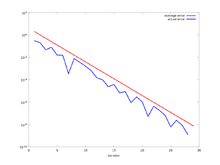Exercises on the bisection method/Solution
< Exercises on the bisection method
Numerical analysis > Exercises on the bisection method/Solution
Exercise 1
- The following is a possible implementation of the bisection method with Octave/MATLAB:
function [x e iter]=bisection(f,a,b,err,itermax)
%The function bisection find the zeros of function
%with the bisection algorithm.
%It returns the zero x, the error e, and the number of iteration needed iter
%
%HOW TO USE IT:
%Example
%>>f=@(x)x.^3;
%>>a=-1; b=2;
%>>err=1e-5; itermax=1000;
%>>[x e iter]=bisection(f,a,b,err,itermax);
e=b-a;
iter=0;
fa=f(a);
if( fa .* f(b) >= 0 )
x =[];
disp("f(a) * f(b) >= 0! No solution!")
else
while( e > err )
iter = iter + 1;
x = 0.5 * ( b + a )
e = abs(b - x);
fx = f(x);
if( fx == 0 )
break;
elseif( fx * fa > 0 )
a = x;
fa = fx;
else
b = x;
end
if( iter == itermax)
break;
end
end
end
- The solution of the points 1, 2 e 3 can be found in the example of the bisection method.
For point 4 we have
 ,
,
so we would need at least 70 iterations. The chance of convergence with such a small precision depends on the calculatord: in particular, with Octave, the machine precision is roughly  . For this reason it does not make sense to choose a smaller precision. The number of iterations, if we don't specify a maximum number, would be infinite.
. For this reason it does not make sense to choose a smaller precision. The number of iterations, if we don't specify a maximum number, would be infinite.
Exercise 2
- To verify the existence of a root
 we need to show that the hypothesis roots theorem are satisfied. The first hypothesis requires
we need to show that the hypothesis roots theorem are satisfied. The first hypothesis requires  to be continuous. Obviosly this is a continuous function since it is sum of two continuous functions. The second hypotheses requires the function to have oppiste signs at the interval extrema, and in fact we find
to be continuous. Obviosly this is a continuous function since it is sum of two continuous functions. The second hypotheses requires the function to have oppiste signs at the interval extrema, and in fact we find
 .
. Comparison of the average and actual errors computed with the bisection method in logarithmic scale..
Comparison of the average and actual errors computed with the bisection method in logarithmic scale..- To show the uniqueness of the root we need to prove that the function
 is monotone and in fact
is monotone and in fact ![f'(x)=e^x-2x > 0 \quad \forall x \in [-2, 0]](../I/m/2f19475cfe1c687028c792a236dd32f2.png) .
.
- The number of iterations need is given by
 ,
,- and so we have
 .
.
- The interval
![[-2,-1]](../I/m/9b03926afdfad73896be89ba37623f7d.png) does not contain aany root as the second hypotesis of the roots theorem fails, in fact
does not contain aany root as the second hypotesis of the roots theorem fails, in fact
 .
.

- In the plot we show in red the average errorand in blu the actual error. From the graph, it is clear that the actual error is not a monotone function. Moreover, note that the global behavior of both curves is the same, clarifying the term average error for
 .
.
Exercise 3
For the solution look at the convergence analysis in the bisection method page.
This article is issued from Wikiversity - version of the Thursday, October 11, 2012. The text is available under the Creative Commons Attribution/Share Alike but additional terms may apply for the media files.